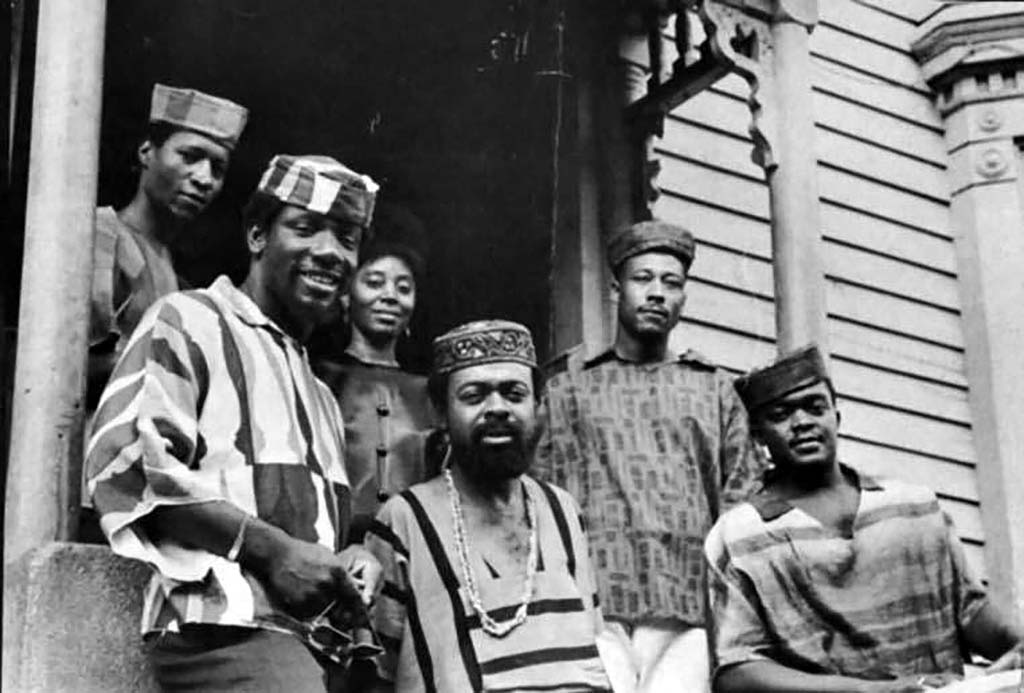The Black Arts Movement Created Specific African American Literature

Amiri Baraka (middle) and Yusef Iman (second from left) with musicians and actors of the blackness arts move, Spirit House, Newark, New Bailiwick of jersey, 1966
Fair Use Image, Courtesy Howard University Digital Collections (mss_5584)
The Black Arts Move was the name given to a group of politically motivated blackness poets, artists, dramatists, musicians, and writers who emerged in the wake of the Black Ability Motility. The poet Imamu Amiri Baraka is widely considered to exist the father of the Blackness Arts Movement, which began in 1965 and concluded in 1975.
After Malcolm Ten was assassinated on Feb 21, 1965, those who embraced the Black Ability motion often fell into 1 of ii camps: the Revolutionary Nationalists, who were all-time represented by the Blackness Panther Party, and the Cultural Nationalists. The latter group called for the creation of poetry, novels, visual arts, and theater to reverberate pride in black history and civilization. This new emphasis was an affirmation of the autonomy of black artists to create blackness art for blackness people as a ways to awaken black consciousness and accomplish liberation.
The Black Arts Motion was formally established in 1965 when Baraka opened the Black Arts Repertory Theater in Harlem. The motion had its greatest touch in theater and poetry. Although it began in the New York/Newark area, it soon spread to Chicago, Illinois, Detroit, Michigan, and San Francisco, California. In Chicago, Hoyt Fuller and John Johnson edited and published Negro Digest (later Black World), which promoted the piece of work of new black literary artists. Also in Chicago, Third World Press published black writers and poets. In Detroit, Lotus Press and Broadside Press republished older works of black poetry. These Midwestern publishing houses brought recognition to edgy, experimental poets. New black theater groups were also established. In 1969, Robert Chrisman and Nathan Hare established The Black Scholar, which was the first scholarly journal to promote black studies inside academia.
There was likewise collaboration between the cultural nationalists of the Black Arts Movement and mainstream black musicians, especially historic jazz musicians including John Coltrane, Thelonious Monk, Archie Shepp, and others. Cultural nationalists saw jazz every bit a distinctly black fine art grade that was more than politically appealing than soul, gospel, rhythm and blues, and other genres of black music.
Although the creative works of the movement were often profound and innovative, they also often alienated both black and white mainstream civilization with their raw shock value which oftentimes embraced violence. Some of the most prominent works were likewise seen equally racist, homophobic, anti-Semitic, and sexist. Many works put forth a blackness hyper masculinity in response to historical humiliation and degradation of African American men but ordinarily at the expense of some black female voices.
The motion began to fade when Baraka and other leading members shifted from Blackness Nationalism to Marxism in the mid-1970s, a shift that alienated many who had previously identified with the move. Additionally Baraka, Nikki Giovanni, Gil Scott-Heron, Maya Angelou, and James Baldwin accomplished cultural recognition and economic success equally their works began to be celebrated by the white mainstream.
The Black Arts Movement left behind many timeless and stirring pieces of literature, poetry, and theater. Ironically despite the male-dominated nature of the movement, several black female writers rose to lasting fame including Nikki Giovanni, Sonia Sanchez, Ntozake Shange, Audre Lorde, June Jordan, among others. Additionally, the Black Arts Movement helped lay the foundation for modern-solar day spoken word and hip-hop.
Exercise you find this information helpful? A modest donation would help us go on this available to all. Forego a bottle of soda and donate its toll to us for the information you simply learned, and experience expert almost helping to make it available to everyone.
BlackPast.org is a 501(c)(3) non-profit and our EIN is 26-1625373. Your donation is fully taxation-deductible.
Cite this article in APA format:
Foster, H. (2014, March 21). The Black Arts Movement (1965-1975). BlackPast.org. https://www.blackpast.org/african-american-history/blackness-arts-movement-1965-1975/
Source of the writer'south information:
Darlene Clark Hine, et al., The African American Odyssey (Upper
Saddle River, New Bailiwick of jersey: Pearson, 2010); Thomas Aiello, "Black Arts
Motility," Encyclopedia of African American History, 1896 to the
Present: From the Historic period of Segregation to the Twenty-first Century, ed.
Paul Finkelman (New York: Oxford University Press, 2008).
Source: https://www.blackpast.org/african-american-history/black-arts-movement-1965-1975/
0 Response to "The Black Arts Movement Created Specific African American Literature"
Post a Comment